tornado
 Tornado warnings and warning sirens are things that just about every person knows about these days, but in 1944, they weren’t available at all. It wasn’t that no one had thought about a tornado warning system, but rather that they had and they decided against it,and so nothing was developed. If you’re like me, you wonder why anyone would think it a bad idea to warn people about the possibility of a tornado, but that was exactly what happened. According to a report titled “The History (and Future) of Tornado Warning Dissemination in the United States” by Timothy A. Coleman, Kevin R. Knupp, James Spann, J. B. Elliott, and Brian E. Peters, “Despite promising research on the conditions that are favorable for tornadoes in the 1880s by John P. Finley, a general consensus was reached among scientists in the 1880s and 1890s that tornado forecasts and warnings would cause more harm than good. A ban was placed on the issuance of tornado warnings from 1887, when the U.S. Army Signal Corps handled weather forecasts, until 1938, when the civilian U.S. Weather Bureau (USWB) finally lifted the ban.” Even after the an was lifted, warnings were pretty primitive. Modern tornado warning really took off and began to develop in 1948…too late for the people of West Virginia and Pennsylvania on June 23, 1944.
Tornado warnings and warning sirens are things that just about every person knows about these days, but in 1944, they weren’t available at all. It wasn’t that no one had thought about a tornado warning system, but rather that they had and they decided against it,and so nothing was developed. If you’re like me, you wonder why anyone would think it a bad idea to warn people about the possibility of a tornado, but that was exactly what happened. According to a report titled “The History (and Future) of Tornado Warning Dissemination in the United States” by Timothy A. Coleman, Kevin R. Knupp, James Spann, J. B. Elliott, and Brian E. Peters, “Despite promising research on the conditions that are favorable for tornadoes in the 1880s by John P. Finley, a general consensus was reached among scientists in the 1880s and 1890s that tornado forecasts and warnings would cause more harm than good. A ban was placed on the issuance of tornado warnings from 1887, when the U.S. Army Signal Corps handled weather forecasts, until 1938, when the civilian U.S. Weather Bureau (USWB) finally lifted the ban.” Even after the an was lifted, warnings were pretty primitive. Modern tornado warning really took off and began to develop in 1948…too late for the people of West Virginia and Pennsylvania on June 23, 1944.
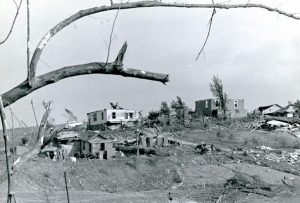
On that June 23rd in 1944, a series of tornadoes across West Virginia and Pennsylvania kill more than 150 people. Most of the twisters were classified as F3, but the most deadly one was an F4 on the Fujita scale, meaning it was a devastating tornado, with winds in excess of 207 miles per hour. The afternoon was very hot, when atmospheric conditions suddenly changed and the tornadoes began to form in Maryland. At about 5:30 pm, an F3 tornado, with winds between 158 and 206 miles per hour, struck in western Pennsylvania. That storm killed two people. Just Forty-five minutes later, a very large twister began in West Virginia, and moved into Pennsylvania. It then tracked back to West Virginia. By the time this F4 tornado ended, it had killed 151 people and leveled hundreds of homes. Another tornado struck that afternoon at a YMCA camp in Washington, Pennsylvania. A letter written by a camper was later found 100 miles away. Area Coal-mining towns were also hit hard on June 23rd. There were some reports that a couple of tornadoes actually crossed the Appalachian mountain range, going up one side and coming down the other…a very rare event with any mountain. Finally, about 10 pm, the remarkable series of twisters finally ended, after the last one hit in Tucker County, West Virginia. In all, the storms caused the  destruction of thousands of structures and millions of dollars in damages, and that was just the monetary losses.
destruction of thousands of structures and millions of dollars in damages, and that was just the monetary losses.
While there isn’t much that can be done to spare property in the path of tornadoes, an early warning, and the appropriate action taken, can save the lives of hundreds of people. Sadly, early warnings were not available to save the 153 people killed in the tornado outbreak of June 23, 1944. They were still in the works, because of all the years wasted when scientists decided it was not in the public’s best interest to know about tornadoes. I’m really thankful that the ban was lifted and we have these necessary warnings these days.
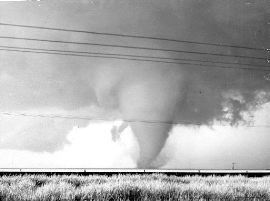 When I think of Tornado Alley, Oklahoma is always among the states that come to mind, but I didn’t know which tornado would be considered the worst one in the states history. Nor did I know that the 1947 Woodward Tornado would continue to hold that status year after year. The most deadly tornado to ever strike within the borders of the state of Oklahoma occurred on Wednesday, April 9, 1947 in the city of Woodward, and across Texas and Kansas. The Woodward tornadic storm actually began in the Texas Panhandle that afternoon, and produced at least six tornadoes along a 220 mile path that stretched from White Deer, Texas, northeast of Amarillo, to Saint Leo, Kansas, west of Wichita.
When I think of Tornado Alley, Oklahoma is always among the states that come to mind, but I didn’t know which tornado would be considered the worst one in the states history. Nor did I know that the 1947 Woodward Tornado would continue to hold that status year after year. The most deadly tornado to ever strike within the borders of the state of Oklahoma occurred on Wednesday, April 9, 1947 in the city of Woodward, and across Texas and Kansas. The Woodward tornadic storm actually began in the Texas Panhandle that afternoon, and produced at least six tornadoes along a 220 mile path that stretched from White Deer, Texas, northeast of Amarillo, to Saint Leo, Kansas, west of Wichita.
The town of Woodward, Oklahoma was hit head on, and was nearly wiped off the map by the powerful tornado. More than 100 people died in Woodward, and 80 more lost their lives 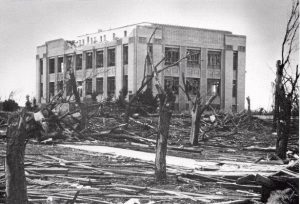 elsewhere in the series of twisters that hit the heartland of the United States that day. The tornado that struck Woodward actually began near Canadian, Texas. It moved northeast, continuously on the ground for about 100 miles, ending in Woods County, Oklahoma, west of Alva. The tornado was massive, measuring up to 1.8 miles wide, and moved along its path at speeds of about 50 miles per hour. It first struck Glazier and Higgins in the Texas Panhandle, bringing devastation to both towns and killing at least 69 people in Texas before crossing into Oklahoma. In Ellis County, Oklahoma, the tornado did not strike any towns, passing to the southeast of Shattuck, Gage, and Fargo. Nevertheless, while no towns were struck, 60 farms and ranches were destroyed and 8 people were killed and 42 injured. In Woodward County, one death was reported near Tangier.
elsewhere in the series of twisters that hit the heartland of the United States that day. The tornado that struck Woodward actually began near Canadian, Texas. It moved northeast, continuously on the ground for about 100 miles, ending in Woods County, Oklahoma, west of Alva. The tornado was massive, measuring up to 1.8 miles wide, and moved along its path at speeds of about 50 miles per hour. It first struck Glazier and Higgins in the Texas Panhandle, bringing devastation to both towns and killing at least 69 people in Texas before crossing into Oklahoma. In Ellis County, Oklahoma, the tornado did not strike any towns, passing to the southeast of Shattuck, Gage, and Fargo. Nevertheless, while no towns were struck, 60 farms and ranches were destroyed and 8 people were killed and 42 injured. In Woodward County, one death was reported near Tangier.
The storm occurred when a cold front from Siberia met a warm and moist stream of air from the Gulf of Mexico, 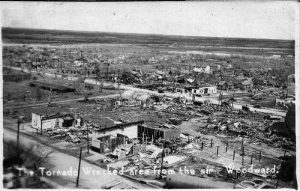 and into Texas. By the time it reached Woodward, some estimated that it was as big as two miles wide. As the storm moved through Woodward, 200 residential blocks were completely leveled and nearly 1,000 homes were razed. Fires broke out in several spots but the heavy rains kept them under control. In all, 107 people were killed in Woodward and many more were injured. The devastating tornado then continued on to Kansas, where significant damage was done but no one was killed. When looting was reported in the areas hit by the tornado, the National Guard was called in to restore order. Army barracks were used to house the homeless until their homes could be rebuilt. Damage caused by this event totaled about $9,700,000.
and into Texas. By the time it reached Woodward, some estimated that it was as big as two miles wide. As the storm moved through Woodward, 200 residential blocks were completely leveled and nearly 1,000 homes were razed. Fires broke out in several spots but the heavy rains kept them under control. In all, 107 people were killed in Woodward and many more were injured. The devastating tornado then continued on to Kansas, where significant damage was done but no one was killed. When looting was reported in the areas hit by the tornado, the National Guard was called in to restore order. Army barracks were used to house the homeless until their homes could be rebuilt. Damage caused by this event totaled about $9,700,000.
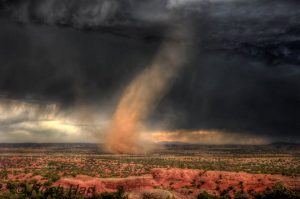 Weather has always been a subject of interest to people, even if we still don’t completely have a full grasp of it, not even after all these years and all our technology. The main difference I see now is that we hear about weather all the time. It’s on television, the radio, and even our phones. There are warnings for everything…thunder storms, tornadoes, snow storms, flash floods, and hurricanes. Nevertheless, all the meteorologists can truly do is predict a weather event. It may or may not materialize.
Weather has always been a subject of interest to people, even if we still don’t completely have a full grasp of it, not even after all these years and all our technology. The main difference I see now is that we hear about weather all the time. It’s on television, the radio, and even our phones. There are warnings for everything…thunder storms, tornadoes, snow storms, flash floods, and hurricanes. Nevertheless, all the meteorologists can truly do is predict a weather event. It may or may not materialize.
Now, flash back to, oh say 1680 or even to 1521. Other than looking at the sky, how did the people predict the weather? Yes the sky can be a great predictor of coming storms, but unless you knew something about weather  patterns, you would be unlikely to have any idea that something like a tornado, flood, or hurricane were coming. Especially in 1680 or 1521. Those dates are rather important in the world of weather. In August of 1521, a meteorological phenomenon occurred in the Basin of Mexico. There were no cameras back them, no cell phones or computers to record the event. The only known description appears in Book XII of the Florentine Codex, which is an account of the Spanish conquest of Mexico written in Nahuatl in the mid-sixteenth century. The account states that just before the fall of Mexico-Tenochtitlan a heavy storm which included a whirlwind struck the basin. The whirlwind hovered for a while above Tlatelolco, Tenochtitlan’s twin city. Then it moved to the lake where it disappeared.
patterns, you would be unlikely to have any idea that something like a tornado, flood, or hurricane were coming. Especially in 1680 or 1521. Those dates are rather important in the world of weather. In August of 1521, a meteorological phenomenon occurred in the Basin of Mexico. There were no cameras back them, no cell phones or computers to record the event. The only known description appears in Book XII of the Florentine Codex, which is an account of the Spanish conquest of Mexico written in Nahuatl in the mid-sixteenth century. The account states that just before the fall of Mexico-Tenochtitlan a heavy storm which included a whirlwind struck the basin. The whirlwind hovered for a while above Tlatelolco, Tenochtitlan’s twin city. Then it moved to the lake where it disappeared.
When the experts of today look at the account of the phenomenon in the context of the Nahua culture, and  comparing it with European descriptions of tornados and waterspouts, they can determine that the phenomenon was indeed a tornado. Their conclusion is further supported by eighteenth and nineteenth century pictorial and written evidence showing that tornadoes do occur in the territory now occupied by Mexico City. Since the tornado of Tlatelolco predates the Cambridge, Massachusetts, tornado of July 8, 1680, which had been thought to be the first recorded tornado in the Americas, the Tlatelolco tornado actually represents the earliest documented tornado in the Americas. Either way, since people didn’t really have much information to go on back then, I’m sure they first said some version of “What is that?!!?” At least, I know I would have.
comparing it with European descriptions of tornados and waterspouts, they can determine that the phenomenon was indeed a tornado. Their conclusion is further supported by eighteenth and nineteenth century pictorial and written evidence showing that tornadoes do occur in the territory now occupied by Mexico City. Since the tornado of Tlatelolco predates the Cambridge, Massachusetts, tornado of July 8, 1680, which had been thought to be the first recorded tornado in the Americas, the Tlatelolco tornado actually represents the earliest documented tornado in the Americas. Either way, since people didn’t really have much information to go on back then, I’m sure they first said some version of “What is that?!!?” At least, I know I would have.
 My niece, Jenny Spethman is a woman of many talents. She is first and foremost a woman of God, who loves the Lord with all her heart. Life has not always been a bed of roses for Jenny, but through it all, she and her husband, Steve made God their center, and He has given then the strength to weather the storms that life brings…and some of these were hurricanes or tornadoes. Most weren’t literally that type, but they did fly through the edge of a hurricane on their way to their honeymoon, so they learned to trust God very early on in their marriage. The loss of their daughter, Laila at 22 days old, is something that would have ripped many a marriage apart, but not Jenny and Steve. They pressed into the Lord, and learned to seek His comfort in all the sad days that followed her passing. God has carried them through…every storm.
My niece, Jenny Spethman is a woman of many talents. She is first and foremost a woman of God, who loves the Lord with all her heart. Life has not always been a bed of roses for Jenny, but through it all, she and her husband, Steve made God their center, and He has given then the strength to weather the storms that life brings…and some of these were hurricanes or tornadoes. Most weren’t literally that type, but they did fly through the edge of a hurricane on their way to their honeymoon, so they learned to trust God very early on in their marriage. The loss of their daughter, Laila at 22 days old, is something that would have ripped many a marriage apart, but not Jenny and Steve. They pressed into the Lord, and learned to seek His comfort in all the sad days that followed her passing. God has carried them through…every storm.

Jenny loves being a wife and mother. Her family is her everything. She attends the boys, Xander, Zack, and Isaac’s sporting events, and her daughter, Aleesia’s girly events, like dancing, cheerleading. With the boys in school all day, Jenny and Aleesia have had more time to spend doing girly time. The sad thing is that now, Aleesia is almost ready for full time school too, so Jenny is in the process of deciding who she will be then. I have been in that situation too, so I understand how that feels. When you are no longer a full time caregiver, as in my case, or a full time mommy, as in Jenny’s case, you start to think, “Ok, then who am I?” It’s a question every mom has to answers at some point.

The reality is that everyone has these moments when they need to basically re-invent themselves. Jenny is trying to decide now, if she will go back to school or go to work. I totally understand the vast array of feelings she has about this. She will miss being the stay-at-home mom, with all the kids around her, but there is a type of excitement that comes with a new adventure, be it work or study. All new adventures are often bittersweet…exciting on the one side, but sad too, because you are leaving the time of your children’s babyhood behind. Bittersweet as it may be, I know that Jenny will weather this storm just fine too. Today is Jenny’s birthday. Happy birthday Jenny!! Have a great day!! We love you!!
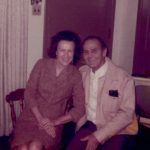
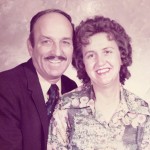 Saturday afternoon, after hiking the Bridle Trail on Casper Mountain, Bob and I went up to hike the Braille Trail with our daughter, Corrie Petersen, her husband Kevin and her son, Josh. Black out glasses were provided to give a sighted person an idea of what it is like to travel through life blind. Josh and I decided to hike that way, and what an experience that was. I must say that Blind Man’s Bluff will not prepare you for the reality of going through life blind. I have a lot of respect for any blind person who gets out and lives their life on their own terms. It would take a lot of courage. Of course, since I cannot read Braille, we took off the glasses at each sign that told about the area. It was very interesting to hear about the rocks, trees, the creek, and plant life we were seeing around us.
Saturday afternoon, after hiking the Bridle Trail on Casper Mountain, Bob and I went up to hike the Braille Trail with our daughter, Corrie Petersen, her husband Kevin and her son, Josh. Black out glasses were provided to give a sighted person an idea of what it is like to travel through life blind. Josh and I decided to hike that way, and what an experience that was. I must say that Blind Man’s Bluff will not prepare you for the reality of going through life blind. I have a lot of respect for any blind person who gets out and lives their life on their own terms. It would take a lot of courage. Of course, since I cannot read Braille, we took off the glasses at each sign that told about the area. It was very interesting to hear about the rocks, trees, the creek, and plant life we were seeing around us.
Then, we read the sign about the tornado that had torn through the Braille Trail in 1978. My memory files immediately took me back to July 20, 1978 at 6:40pm. No, I didn’t know that July 20th was the exact date or that 6:40pm was the exact time, but I’m quite sure it was. My Aunt Ruth Wolfe and her family had come to town to celebrate my parents’ 25th Wedding Anniversary, which was July 18, 1978. The memory was so vivid in my memory files that I can clearly see my Aunt Ruth standing in my parents’ kitchen. Suddenly, she stopped talking and almost ran to the back door. She said, “There’s a tornado somewhere!” She was so serious, but I was still skeptical…until we heard that there had indeed been a tornado on Casper Mountain at that exact time. I was stunned. How could she have known that? I was a young mother of two girls then, and had never been around a tornado. Casper doesn’t get a lot of them, even though we have had warnings, and even tornadoes in the area. Casper Mountain gets even fewer tornadoes than the main Casper area. Still, my aunt, who had been around a few of them, knew the atmospheric changes that precede a tornado, and she was certain that one had struck somewhere in our immediate area.
Now, over 38 years later, while walking a trail on the mountain, that whole scene replayed in my mind. Life is strange that way. Sometimes, memories come in and out of your life like you are watching a movie. It seemed so real that I felt like I could have walked across the room and touched my aunt. I remembered always being 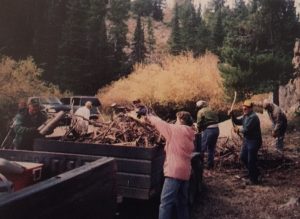 amazed at the wisdom she had concerning tornadoes. In reality, all of my parents siblings were that way. They had the wisdom that comes with their years on the earth. That was how Aunt Ruth got her wisdom too…living life. It was a great memory of her. As to the Braille Trail, since it had the dedication of the Lions Club and the community, the people came together, cleaned it up, and repaired the damage. The Braille Trail has been damaged a total of three times over the years of its existence…the 1978 tornado, the 1985 flood, and the 1995 winter storms, each time the damaged trees were removed, and the trail areas rebuilt, so that the trail could continue to serve the visually impaired and the community at large. I know I will definitely go back again.
amazed at the wisdom she had concerning tornadoes. In reality, all of my parents siblings were that way. They had the wisdom that comes with their years on the earth. That was how Aunt Ruth got her wisdom too…living life. It was a great memory of her. As to the Braille Trail, since it had the dedication of the Lions Club and the community, the people came together, cleaned it up, and repaired the damage. The Braille Trail has been damaged a total of three times over the years of its existence…the 1978 tornado, the 1985 flood, and the 1995 winter storms, each time the damaged trees were removed, and the trail areas rebuilt, so that the trail could continue to serve the visually impaired and the community at large. I know I will definitely go back again.
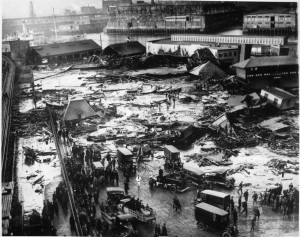 These days, most tsunami waves come with prior warning…at least since the 1946 wave that hit Alaska and Hawaii. Nevertheless, there are disastrous waves that are largely unpredictable, and those can be as deadly as the ones that the Pacific Tsunami Warning System warns people about. One in particular I had never heard of, until my sister Cheryl Masterson heard about it and mentioned it a few days ago. It happened in Boston, Massachusetts on January 15, 1919, and while it was of a very different variety than most tsunamis, it was deadly nevertheless. This tsunami was so strange, in fact, that most people wouldn’t even believe that this is a true story, but it did happen.
These days, most tsunami waves come with prior warning…at least since the 1946 wave that hit Alaska and Hawaii. Nevertheless, there are disastrous waves that are largely unpredictable, and those can be as deadly as the ones that the Pacific Tsunami Warning System warns people about. One in particular I had never heard of, until my sister Cheryl Masterson heard about it and mentioned it a few days ago. It happened in Boston, Massachusetts on January 15, 1919, and while it was of a very different variety than most tsunamis, it was deadly nevertheless. This tsunami was so strange, in fact, that most people wouldn’t even believe that this is a true story, but it did happen.
Around 12:40pm on January 15, 1919, a storage tank holding 2.3 million gallons of molasses exploded at the Purity Distilling Co. in the North End of Boston, sending waves of molasses rushing through the streets at almost 35 miles per hour. I’m sure that many people wouldn’t even think of this event as being at all dangerous, I mean after all, it’s just molasses. Nevertheless, a 25 foot high wave of molasses coming at you going 35 miles per hour is as deadly as being hit be a car. There was no warning, and in reality, there couldn’t  be. The molasses was being stored in the tank awaiting transfer to another plant and, due to its quickly rising temperature, it set off a tragic and previously unheard of chain of events. According to witnesses, the ground shook as if a tornado or freight train were coming down the street.
be. The molasses was being stored in the tank awaiting transfer to another plant and, due to its quickly rising temperature, it set off a tragic and previously unheard of chain of events. According to witnesses, the ground shook as if a tornado or freight train were coming down the street.
According to The Boston Globe, citizens “were picked up by a rush of air and hurled many feet.” A truck itself was picked up by the gushing wave and thrown into Boston Harbor. The force of the wave was so destructive, it almost tipped a railroad car off of Boston’s elevated railway tracks.” And The Boston Post described the gruesome scene, “Molasses, waist deep, covered the street and swirled and bubbled about the wreckage. Here and there struggled a form — whether it was animal or human being was impossible to tell. Horses died like so many flies on sticky fly-paper. The more they struggled, the deeper in the mess they were ensnared. Human beings — men and women — suffered likewise.”
The final death toll was set at 21, while 150 people were injured. The dead were either crushed by debris filled molasses, or drowned by the molasses itself. People and animals were seen struggling, some for which nothing could be done. The clean up was massive. Fire trucks were brought in to hose down the streets, and welders to 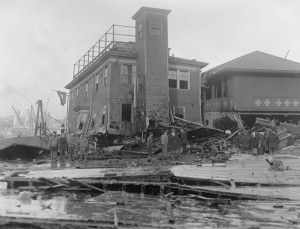 cut the tank up. The harbor was brown until summer. The molasses seeped into every crack, and it is said that on hot summer days, you could smell it for decades. I’m not sure how that could be, but maybe their minds played tricks in them too. In the end, the public outcry made a lawsuit necessary. The townspeople brought a class-action suit against the United States Industrial Alcohol Company, which had recently bought the Purity Distilling Company. Three years of hearings later, the USIAC was found guilty and forced to pay $600,000, which would equate to almost $10 million today, in settlements for negligence. The wave was as deadly as any tsunami could have been, but in reality, no warning could have prevented this tragedy.
cut the tank up. The harbor was brown until summer. The molasses seeped into every crack, and it is said that on hot summer days, you could smell it for decades. I’m not sure how that could be, but maybe their minds played tricks in them too. In the end, the public outcry made a lawsuit necessary. The townspeople brought a class-action suit against the United States Industrial Alcohol Company, which had recently bought the Purity Distilling Company. Three years of hearings later, the USIAC was found guilty and forced to pay $600,000, which would equate to almost $10 million today, in settlements for negligence. The wave was as deadly as any tsunami could have been, but in reality, no warning could have prevented this tragedy.
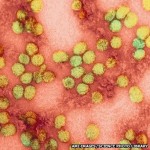 When I come across a husband and wife, who both died on the same day, my curiosity kicks into overdrive. That just seems so unusual. Nevertheless, such was the case for my husband, Bob’s 4th great grandparents, Cloudsbury and Elizabeth Kirby, both of whom died on August 29, 1878 in Mount Ayr, Ringgold County, Iowa. At first, I wondered if it was an error, and I suppose it could be, but that is the information I have at this point, so that is what I have to go with.
When I come across a husband and wife, who both died on the same day, my curiosity kicks into overdrive. That just seems so unusual. Nevertheless, such was the case for my husband, Bob’s 4th great grandparents, Cloudsbury and Elizabeth Kirby, both of whom died on August 29, 1878 in Mount Ayr, Ringgold County, Iowa. At first, I wondered if it was an error, and I suppose it could be, but that is the information I have at this point, so that is what I have to go with.
My first thought was to check for disasters in the area, like tornados, fires, or floods, but I was unable to find anything that specifically happened in Mount Ayr, Iowa on August 29, 1878. Looking for these kinds of specific things can be a long and frustrating process, but I just can’t imagine too many situations where both halves of a couple would pass on the same day. I searched and found that there were tornadoes during that year, but nothing specifically on that day, so I doubt that a tornado is the culprit here.
When the possibility of a disaster was removed, I began to think about illness, so I looked up and epidemics in the area. That is when I came across a definite possibility…the Yellow Fever Epidemic of 1876 to 1878, which took many lives in the southern United States. Yellow fever, known historically as yellow jack or yellow plague is an acute viral disease, that is usually spread by the female mosquito. Symptoms include fever, chills, loss of appetite, nausea, muscle pains particularly in the back, and headaches. Many people improve after a few days, but when the symptoms return, they can cause kidney damage, liver failure (causing yellow skin, probably the reason for the name Yellow Fever), bleeding, and ultimately death. These days there is a vaccine against Yellow Fever and some countries require it for travelers. Other countries try to control the virus by killing off as many mosquitoes as possible. Nevertheless, Yellow Fever causes 200,000 infections and 30,000 deaths every year with nearly 90% of those occurring in Africa, these days. Since the 17th century, several major outbreaks have occurred in America, Africa, and Europe. In the 18th and 19th centuries yellow fever was seen as the most dangerous of infectious diseases.
I can’t say for sure that Yellow Fever is what took the lives of Bob’s 4th great grandparents, but with the epidemic that occurred during that time, I have to think that it is a possibility. I have looked at the lists of people know to have died of Yellow Fever during that epidemic, and did not see Cloudsbury and Elizabeth Kirby on the list, but the list was incomplete, with many people only listed as a number. At this time, unless more information somehow surfaces, I will probably never know for sure, but the epidemic, which apparently came in from Cuba caused 100,000 people to become ill, and killed 20,000 people, so it is likely that they were too busy, trying to help people get better, to keep really great records as to the names of the dead. I have to feel really sorry for people of that time. They didn’t really know what was causing the epidemic and would not have had a way to do much about it anyway, so many lives were lost. Thankfully for the people of this century, Yellow Fever can be prevented by vaccination, and it is usually found in Africa, so we don’t really see much of it here.
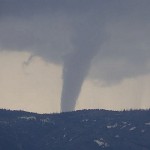 Yesterday’s rare tornado on Casper Mountain while not scary, because I didn’t know about it until it was over, did take me back a in time a bit, however. A number of years ago, my Aunt Ruth and Uncle Jim Wolfe were at my mom’s house visiting, we were under a tornado watch. No one was worried about it because it was only a watch, and we didn’t expect anything to come of it. I think we were under the mistaken assumption that we would never have a tornado here…at least I think I was. I’m sure the adults knew that a tornado could happen anywhere, but I was a kid, and I still wanted that cushion of protection. It’s a lot more comfortable to a child to think that these bad things can never come here, and you don’t want your dream world shattered. All too soon you reach an age where you know that storms like these are possible anywhere, and you become watchful, just like my Aunt Ruth was.
Yesterday’s rare tornado on Casper Mountain while not scary, because I didn’t know about it until it was over, did take me back a in time a bit, however. A number of years ago, my Aunt Ruth and Uncle Jim Wolfe were at my mom’s house visiting, we were under a tornado watch. No one was worried about it because it was only a watch, and we didn’t expect anything to come of it. I think we were under the mistaken assumption that we would never have a tornado here…at least I think I was. I’m sure the adults knew that a tornado could happen anywhere, but I was a kid, and I still wanted that cushion of protection. It’s a lot more comfortable to a child to think that these bad things can never come here, and you don’t want your dream world shattered. All too soon you reach an age where you know that storms like these are possible anywhere, and you become watchful, just like my Aunt Ruth was.
As we were visiting, no one was really paying attention to the weather. Suddenly, my Aunt Ruth jumped up and ran to the back door. She looked out the window and said, “There is a tornado somewhere!!” I remember thinking, “No way!! We don’t get those here!!” She insisted that there had been one, but with no way to confirm it right then, they went back to their conversation. I, on the other hand felt a little apprehensive for the rest of the evening. I kept thinking, “Tornados don’t happen here, do they…or do they? Is it save to be here? Should we be going somewhere to hide r something?” Still the adults didn’t seem too concerned, so I went back to what I was doing too, but the memory of that moment has really never left me. I can still vividly see my Aunt Ruth standing at the back door, looking at the sky for clues as to the location of the tornado. I can still hear her voice, clearly saying that there was a tornado somewhere. She was so sure of it
Later that night, as we were watching the news, the weather man said that there had been a tornado on the mountain. I was a little shaken up by that report. The memory of that moment has lived in my memory files for all those years. I don’t know exactly how she knew it that day, but she did. I think I was a little bit in awe of her knowledge of storm systems. I suppose that was because she had been right about it. Now, of course we have things like radar, and  rotation patterns to tell us ahead of time that something is coming, but I am here to tell you that those systems don’t always do exactly what they are supposed to do. Yesterday’s tornado on Casper Mountain did not set of any of the warning systems. I wondered how that could be, until I found out that the tornado was called a Land Spout Tornado, and apparently those don’t show a rotation pattern that can be picked up by radar. So even with all the warning systems we have, no system is fool proof, and there can be the rogue storm the goes against everything known to man concerning storms. Still, they happen. I suppose that then the only warning system is a person to can feel the weather, like Aunt Ruth.
rotation patterns to tell us ahead of time that something is coming, but I am here to tell you that those systems don’t always do exactly what they are supposed to do. Yesterday’s tornado on Casper Mountain did not set of any of the warning systems. I wondered how that could be, until I found out that the tornado was called a Land Spout Tornado, and apparently those don’t show a rotation pattern that can be picked up by radar. So even with all the warning systems we have, no system is fool proof, and there can be the rogue storm the goes against everything known to man concerning storms. Still, they happen. I suppose that then the only warning system is a person to can feel the weather, like Aunt Ruth.
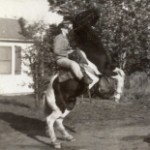 Anytime you read through a well written family history book, you are bound to find things out about your family members that you never knew…even if you knew them all your life. The big thing is, I guess, that sometimes when things are in the past, they are viewed as ancient history. We all do things when we are young that we don’t continue into adulthood. I knew many things about my Aunt Ruth through the years. She loved animals, gardening, and the mountains of Washington. She was an artist both in paintings and music. She painted a picture of herself that I would have thought was painted by a professional artist…along with other paintings. She could play any instrument that she picked up, as if she had been playing it all her life. She knew things about the weather that surprised me as a child…like the time they were at our house. Aunt Ruth suddenly jumped up and looked out the window. She said there is a tornado somewhere. I thought she saw something, but it was the way the wind suddenly stopped where we were that caused her to think that. I heard later that a small twister was reported on Casper Mountain. I never forgot that she had somehow known.
Anytime you read through a well written family history book, you are bound to find things out about your family members that you never knew…even if you knew them all your life. The big thing is, I guess, that sometimes when things are in the past, they are viewed as ancient history. We all do things when we are young that we don’t continue into adulthood. I knew many things about my Aunt Ruth through the years. She loved animals, gardening, and the mountains of Washington. She was an artist both in paintings and music. She painted a picture of herself that I would have thought was painted by a professional artist…along with other paintings. She could play any instrument that she picked up, as if she had been playing it all her life. She knew things about the weather that surprised me as a child…like the time they were at our house. Aunt Ruth suddenly jumped up and looked out the window. She said there is a tornado somewhere. I thought she saw something, but it was the way the wind suddenly stopped where we were that caused her to think that. I heard later that a small twister was reported on Casper Mountain. I never forgot that she had somehow known.
As I said, I knew Aunt Ruth loved animals, and I had seen pictures of her with several horses. I could tell that she was a pretty good horsewoman. I never had very much to do with horses, so seeing her seated firmly on her horse as he reared up, struck me as an amazing feat. And I knew that the family owned horses, and all the kids, my Aunt Laura, my Uncle Bill, my dad, and Aunt Ruth, road regularly, but never was there any mention of racing except in what I read today. Uncle Bill was describing the scene of one of the pictures he had put in the book, and he said that the horse was Aunt Ruth’s race horse, which she did ride in some races. He doesn’t specify how she did in the races she ran, but if it is like pretty much anything else  Aunt Ruth did, she was probably pretty good at it.
Aunt Ruth did, she was probably pretty good at it.
I had to wonder why I had never heard about her racing before, and if I was the only one in the family who didn’t know about it? Why was it that Aunt Ruth never talked about racing? I also wondered if it was something that she thought about doing professionally as a young girl, or if it was always just something she did to pass the time and to test her horse. If no one else in the family knew about her racing either, I suppose that it is something that will drift into the unknown past…except for that one little mention of it in Uncle Bill’s family history books.
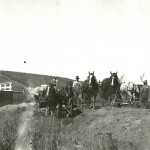 For any one whose ancestors came out to the West, homesteading probably is a word we know, and something we know a little about. Even if it is back in the history of our family, we knew that yes, the land was given to the homesteader, but in reality, they earned every blade of grass that was on their homestead. Homesteading was no easy way to live. Homesteading began when the United States government decided to give 65 acres to anyone who wanted to move out west and settle. They had to work the land for 5 years and then it became theirs. This all sounded like an amazing opportunity to many people, but there were many who came out west to get a homestead and then went back home before the 5 year timeframe was passed. They just couldn’t make it. The didn’t have what it takes. Homesteading was not a lazy man’s way to get land. This land was hard and full of rocks and trees. It had not been plowed and planted before. They would be the first to do that, and they didn’t have all the equipment we have these days to plow up the hard soil so it was suitable for growing crops on.
For any one whose ancestors came out to the West, homesteading probably is a word we know, and something we know a little about. Even if it is back in the history of our family, we knew that yes, the land was given to the homesteader, but in reality, they earned every blade of grass that was on their homestead. Homesteading was no easy way to live. Homesteading began when the United States government decided to give 65 acres to anyone who wanted to move out west and settle. They had to work the land for 5 years and then it became theirs. This all sounded like an amazing opportunity to many people, but there were many who came out west to get a homestead and then went back home before the 5 year timeframe was passed. They just couldn’t make it. The didn’t have what it takes. Homesteading was not a lazy man’s way to get land. This land was hard and full of rocks and trees. It had not been plowed and planted before. They would be the first to do that, and they didn’t have all the equipment we have these days to plow up the hard soil so it was suitable for growing crops on.
My grandparent were among those who came out and earned that homestead, by working that land and making it grow the crops they wanted it to grow. I doubt that they got by without ever losing a crop, because hail, drought, flood, fire, and tornados were bound to have happened at least once during that 5 year timeframe, but they stuck it out and made it work. They proved that they were tough enough to earn that homestead…to the government and to themselves.
Now, don’t get me wrong, I don’t think that the ones that went home were no good, they just didn’t have what it took to make it in the old west. This was rough country, and you  had to be tough to stick it out here. They had to learn to get along with the Indians too, because the Indians weren’t real happy with the White Man being here at all. Treaties had been broken to allow the west to be settled, and they didn’t like it one bit. I think we can all agree that this country was going to expand one way or the other, because as people have children and those children have children, and those children have children, and so on…well, more space was bound to be needed. Still, I suppose we should have handled it in a different way. Nevertheless, many White Men made peace with the Indians, and learned to live together. The White Man had come to the West. He was here to stay, because he had earned that homestead.
had to be tough to stick it out here. They had to learn to get along with the Indians too, because the Indians weren’t real happy with the White Man being here at all. Treaties had been broken to allow the west to be settled, and they didn’t like it one bit. I think we can all agree that this country was going to expand one way or the other, because as people have children and those children have children, and those children have children, and so on…well, more space was bound to be needed. Still, I suppose we should have handled it in a different way. Nevertheless, many White Men made peace with the Indians, and learned to live together. The White Man had come to the West. He was here to stay, because he had earned that homestead.

